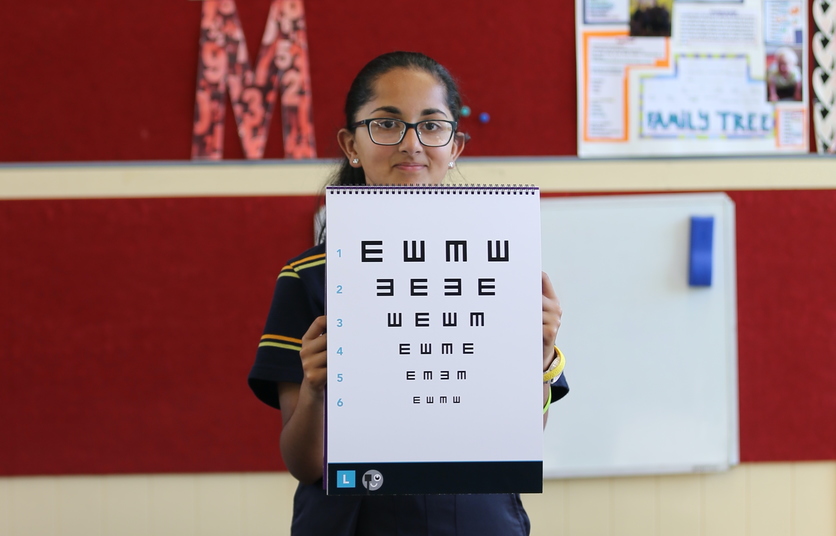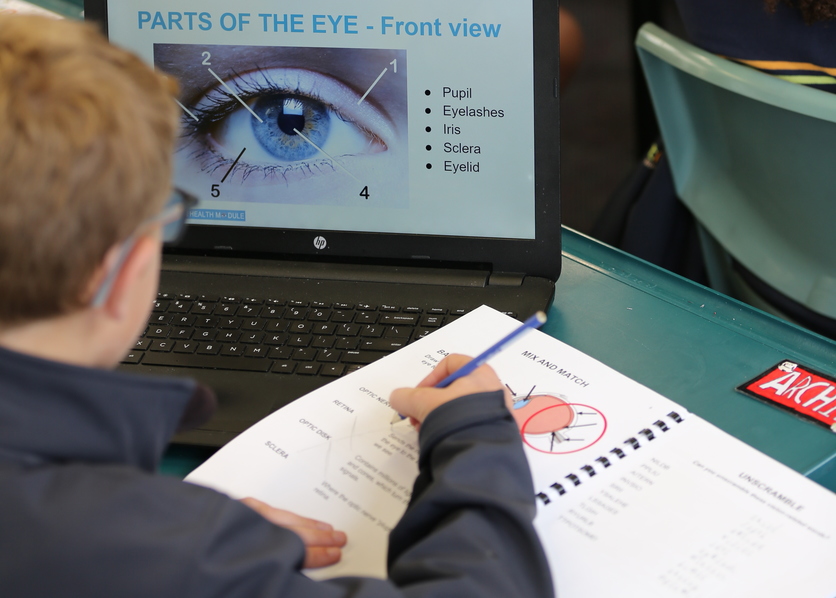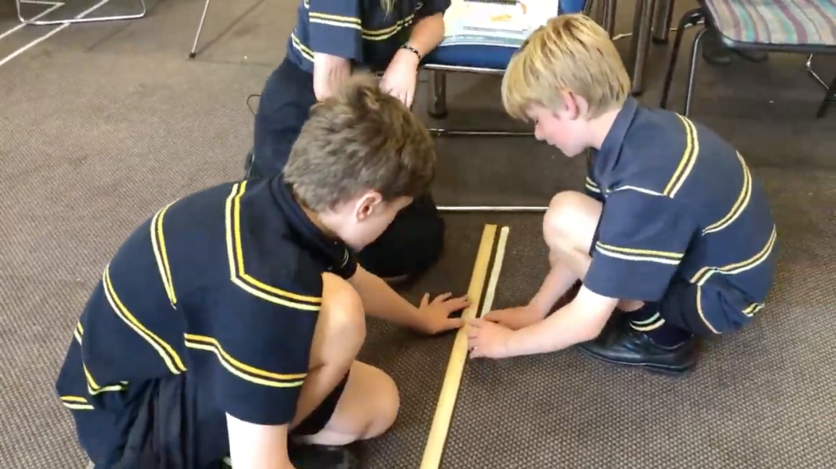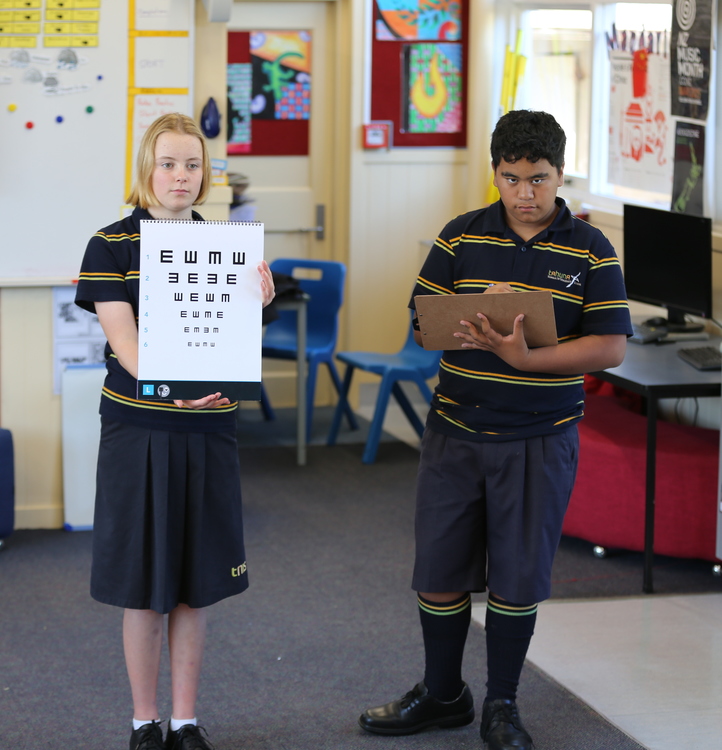The inspiration for this unit came from Otago Polytechnic. Professor Mary Butler is an occupational therapist who specialises in participatory projects. She became intrigued by the wicked problem of lack of awareness of eye health, and her students came up with the concept of child-to-child vision screening.
This is a novel idea of both trusting and teaching children to take responsibility for fair testing of their own vision. It moves vision screening away from the health system and into the hands of children and teachers as the experts in vision science and eye health. The intention is that the unique concept of child-to-child (or peer-to-peer) vision screening can create a conversation in the community in ways that will also reach parents.
This project has come about in the context of the World Health Organization’s World report on vision (2019), which revolutionised the definition of visual impairment by including people who need glasses. It states that a person who needs glasses and does not have them is effectively disabled. The report estimates there are 949.4 million people in the world who need glasses and who do not have them. The solution to this wicked problem involves finding creative approaches to integrated people-centred eye care.
New Zealand does have vision screening at three points (newborn, age 4 and age 11), but these are not done in a truly systematic public health manner. For example, the screening at age 11 is carried out in school, and success depends on a number of factors, including the child being present on that day and their parents receiving and acting on the letter from the school. Research indicates that parents have many difficulties in following up and taking their children to see an optometrist.
Teachers are in an ideal position to identify and respond to children whose learning is impacted by the need for glasses because vision is so essential to the tasks of learning. Teachers can observe the behavioural outcomes for a child who cannot see. This includes children who move around the classroom to see the board, who don’t enjoy reading, who have social issues because they cannot read facial cues, who do not enjoy playing ball and who are disruptive in various ways because they do not recognise that they cannot see adequately.
Intended learning outcomes
The intended learning outcomes were linked to the New Zealand Curriculum science and health outcomes.
The primary outcome was to integrate a child-to-child vision testing toolkit that gives students the opportunity to test their peers’ eyesight through fair testing.
The secondary outcome was to develop teaching and learning opportunities for students to understand about the eye and the importance of good eye health in relation to wellbeing.
Level 4 science concepts
Investigating in science
- Build on prior experiences, working together to share and examine their own and others’ knowledge.
- Ask questions, find evidence, explore simple models and carry out appropriate investigations to develop simple explanations.
Participating and contributing
- Use their growing science knowledge when considering issues of concern to them.
- Explore various aspects of an issue and make decisions about possible actions.
Level 4 health concepts
D1 Societal attitudes and values
- Investigate and describe lifestyle factors and media influences that contribute to the wellbeing of people in New Zealand.
D2 Community resources
- Investigate and/or access a range of community resources that support wellbeing and evaluate the contribution made by each to the wellbeing of community members
Teacher background
When coming on board with this project, I was in my 18th year of teaching. I have a keen interest in science and have led science in both full primary and intermediate schools. I have previously undertaken the Science Teaching Leadership Programme in 2015 and have developed strong community links with a variety of University of Otago science departments. This project was a great opportunity to bring in more community science, focusing on the nature of science as well as giving the students a real-life authentic experience with STEAM education.
Class background
Tahuna Normal Intermediate has been involved with this project for the past 2 years, and 600 year 7 students have participated in child-to-child vision testing. In 2019, the year 7 cohort focused on the testing kit, giving feedback about design and use with a science and STEAM focus. In 2020, the year 7 cohort focused on learning and teaching development, which focused on science and health.
What happened
- Students worked in teams of three to carry out child-to-child vision testing.
- I modelled with three children how to work through the child-to-child vision testing.
- A 4 m strip was measured out onto the carpet.
- Students then used the child-to-child vision testing resources to test each other’s vision.
- The student who was being tested was at one end of the 4 m strip, while the tester and the recorder were at the other end.
- The tester held up a flipchart and read the dialogue and instructions from the reverse side of the flipchart.
- Each child took about 5 minutes to complete the test.
- Once all students had completed their testing, the group worked together to analyse and record the results.
- Follow-up letters are given to any children who may need additional testing with an optician.
- During the unit, there were three modules for students to work through. These were delivered through a combination of PowerPoint lessons and student workbooks.
- The two main teaching modules were ‘Eyesight and eye health’ and ‘Eye conditions and technology’.
- Students also worked through the activities in the student workbook. These activities are designed to support students’ learning about parts of the eye and common eye conditions and to give the students a better understanding and insight into the way their eyes are behaving.
What worked well
Having the students working in teams of three worked really well as it meant that everyone in the group had a job to do. Rotations could be quick, and every child had the opportunity to take on all three roles.
The clear instructions and dialogue printed on the reverse side of the testing flipchart supported the learners and ensured that all students were undergoing the same fair testing for their eyesight test.
The Google Slides presentation had a good balance between the anatomy and the health of the eye. This led to the students asking open-ended questions about how the eye behaved.
Student learning
The students' learning focused around fair testing through the use of the child-to-child vision test, eye health and eye conditions.
It was great to see the children later in the year discussing their eyesight and becoming more aware of any issues.
The students who are just beginning to wear glasses for myopia or hyperopia have developed an understanding of their individual needs and have anecdotally discussed knowing when they need to wear them and when they can “cope” without their glasses.
The challenges
The main challenges with this unit was space for the groups to test as each group required an uninterrupted 4 m space. Tahuna trialled a number of different ways to manage this:
- Half the class worked through follow-up activities while half the class did the testing
- All students carried out testing in a larger space such as the hall.
- Setting up a testing station, and students worked through the one station during the afternoon
When having all the children testing at the same time, it worked better to have the students pointing the directions rather than having them talk as it became too noisy in the classroom.
Another challenge was how to get children to take the next step to see an optometrist. All children who failed an aspect of the testing had a letter sent home. The checking in and following up showed that there are various reasons why visits to the optician were limited.
Researcher’s comment
It was brilliant to work with a teacher who was already so experienced in collaborating and who had a firm grasp both of scientific principles and pragmatic educational and leadership approaches. Communication was key to the process. We were aware that we wanted to get a balance between including Karen as an equal partner in the research process but also not inundating her with project details.
The school committed to the research project from the top down. It was clear that leadership could understand the potential benefit to the children at multiple levels from engaging in the research project and the ongoing integration of child-to-child vision screening into the curriculum.
As researchers, one of the hardest tasks was taking the project through ethical review. Tahuna leadership helped us to navigate this in ways that were both pragmatic and ethically rigorous. Eventually, we came up with a two-phase system where parents could opt out and children could opt in.
Related content
Curious to know more about human vision? These resources will help.
You can hear teacher Karen Parker share her insights on the Vision 20/20 project in this recorded webinar.
Related activities
Use the Labelling the eye activity to learn about and identify parts of the human eye.
The activity Eye dissection uses cows’ eyes – they are a good size for observing many of the parts found in the human eye.
In the activity Pinhole cameras and eyes, students make a pinhole camera and see images formed on an internal screen. They then use a lens and see brighter and sharper images. This models the human eye and can be modified to demonstrate short-sightedness and long-sightedness.
Funding
The Vision 20/20 Project received funding through Otago Science into Action, the Otago pilot of the Participatory Science Platform (PSP) – a programme that is part of the Curious Minds initiative and funded by the Ministry of Business, Innovation and Employment.
The government’s national strategic plan for Science in Society, A Nation of Curious Minds – He Whenua Hihiri i te Mahara, is a government initiative jointly led by the Ministry of Business, Innovation and Employment, the Ministry of Education and the Office of the Prime Minister’s Chief Science Advisor.





